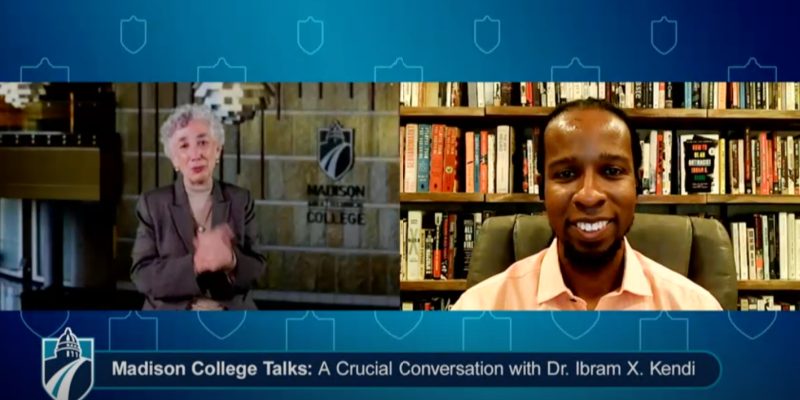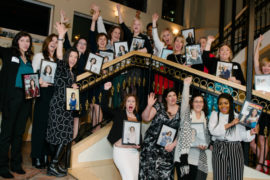By Shelby Rowe Moyer
Talking about racism in the U.S. can be exhausting. Racist systems, policies and actions are being held under light and examined more than ever before. Conversations on a mass scale are being had about racism’s presence in education, health care, careers, neighborhoods, policing, and justice.
How do we maintain hope? How do we raise anti-racist kids? How do you respond to pushback and claims that the U.S. is post-racial?
Ibram X. Kendi, who authored “How to be an Antiracist,” “Stamped from the Beginning” and more, discussed all of this on Nov. 4 in a virtual conversation with Madison College’s Lucia Nunez, vice president of equity, inclusion and community engagement. The event was held in partnership with the Wisconsin Book Festival after the community book club’s reading of “How to be an Antiracist.”
The conversation was stirring and insightful. A lot of thought-provoking ideas were exchanged, and here’s a taste of what was said, in Kendi’s own words.
Responses have been edited for brevity. Questions are paraphrased.
What is Anti-Racism?
Antiracist is the idea of racial equality — that there’s nothing wrong, superior or inferior, better or worse about any racial group. To be antiracist is to recognize that if there’s racial disparities between groups in our society, it’s not because there’s something wrong with a particular racial group — because you believe the racial groups are equal — so the only other explanation is racist policies. To be antiracist is to identify those policies and be part of the larger struggle to eliminate those racist policies and put anti-racist polices in place that have the capacity to create equity and justice for all.
And then finally, to be anti-racist is to have the capacity to admit when we are being racist, and that’s in stark contrast to someone who is being racist, who consistently and regularly denies the ways in which they’re being racist. They consistently argue that they’ve never been racist, and they never will be racist and indeed they’re perfect. To be antiracist is to be imperfect — is to recognize our past and even our present imperfections and have the willingness to identify that when we fail in the future, we’re going to admit it, and we’re going to carry on and strive to be better people.
How Bigotry is Threatening Us
I think in addition to [my] deep and abiding love for humanity, I also know that one of the lethal weapons threatening human existence is racism — or bigotry, more broadly. And so, just as you literally have climate scientists who are waking up every day knowing that if we go another year without having a dramatic sort of response to the climate changing then that could have a catastrophic, existential effect on humankind. I have the same recognition. If we go another year, how many more people are going to die? How many more people are going to be harmed? How many more people are going to be excluded? How many people are going to be looked down upon? How many more presidents are going to be reelected or not reelected? This is what drives me. It’s a calling to save humankind from itself.
How Scholars Are Able to Define Racism
I think it’s important for folks to realize that there are those of us who are scholars, who have the capacity to diagnose a nation or community or institution that’s being racist. That’s our expertise, just like you have physicians who use diagnostic tools, like an MRI or a CT scan to diagnose an illness, to diagnose a cancer. We too have diagnostic tools and those diagnostic tools are definitions — very clear and consistent definitions, which, of course, is what “How to be an Antiracist” is anchored on.
What happens though, when a physician walks into the room or calls me … and we’re told we have cancer. It’s devastating. We feel horrible. It’s nothing we ever want to hear. But we don’t feel that the doctor is trying to hurt us by telling us we have cancer. If anything, we believe the doctor is trying to help us. But when we go in and diagnose someone as being racist and that person feels bad, there’s this belief that we’re trying to hurt or attack the person, as opposed to trying to help them. I want people to really think about that. That’s really what we’re doing. We’re diagnosing people or nations or policies just as doctors are, from our expertise, so that we can help people.
And let’s compare that to the person who is saying, “No you don’t have cancer.” So that nation doesn’t have cancer? So what’s going to happen if we don’t diagnose and treat it? It’s only going to spread. It’s only going to get worse and all the while. … Those of us that are diagnosing the nation as racist — those are the anarchists; those are the people who are trying to destroy the country. No, it’s the people who are saying that this country is post-racial. Those are the folks [who will destroy the country]. That’s the type of idea that will lead to this country dying.
Teaching Children to be Anti-Racist
Studies show the reason why we should be talking to our kids about being anti-racist is because … our kids start understanding race as a concept between 3 and 9 months, and then by 3 years old, they’re already interacting and operating in the world based on racist ideas in the way adults are. …
I think it’s important to know that studies also show, especially for these younger children, particularly under 5 years old, a lot of their socialization in racist ideas have to do with two factors: the community writ large [and parents]. … What we also know that, from their parents, a lot of the socialization is nonverbal. Nonverbal communication seems to be more impactful than verbal communication. So, what that means is — if a child sees a parent has no friends of color, never brings them around people of color — what are you saying to your child?
Or if you’re walking down the street with your child and a Black male is approaching and they can see when you get scared. They can feel it. Kids as early as 2 to 3 years old witness this, and so what do they see? You just got scared by that Black person; Black people are scary. Just like that — that quickly. So that’s why it’s so important for us — if we’re serious about raising our children to value every racial group equally — we have to strive to be antiracist ourselves, and we have to be aggressively seeking to be and do it, so that even our nonverbal communication won’t show racism.
Staying Hopeful
We should not acquire or lose hope based on what’s happening in society. My hopefulness is really unaffected by what’s happening in society. Our hope should be philosophical. We should recognize that in order to bring change, we have to believe change is possible. There’s no way you can be a changemaker if you think change is impossible. This isn’t just in terms of creating an anti-racist society, this is inventing a new product. This is solving a major problem that has persisted … You’re not going to believe you can do it if you think it’s impossible to solve that problem. So to be hopeful is indeed to believe change is possible.




